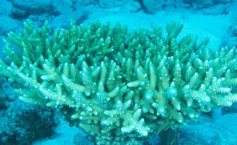 Around the waters of New Zealand we have two types of corals. One being a hard coral, and the other being a soft coral. Both of these types of corals are also found worldwide, more so though in tropical waters.
Around the waters of New Zealand we have two types of corals. One being a hard coral, and the other being a soft coral. Both of these types of corals are also found worldwide, more so though in tropical waters.
The hard corals in New Zealand though are found in the deeper waters, normally 180' or 50 metres and deeper. A common one found in NZ waters is the black coral. Some have been found in shallow water of 25 metres just off the coast of Hahei in the North, and in the sounds of the South Island.
The soft corals I have seen, are mainly around the north eastern coasts in depths of about 15' to 100' or 5 to 30 metres (I am not saying though, that they are not to be found in the Western or Southern parts of New Zealand).
Corals are in fact very very small colonial organizations of polyps much the same as anemones with flowing tentacles but only much smaller in size. These polyps are recognised by the fact that they bear eight tentacles, which are fringed by rows of pinnules, others have multiples of 6.
These soft corals rely on the current for a constant supply of food, and so they tend to face the current so as to filter the most planktonic food. They are most likely to be found on rocky areas where the current is continually moving about and is sometimes reasonably strong.
Corals are carnivores that eat zooplankton. They catch food using tentacles that surround the mouth; the tentacles have poisonous stingers (called nematocysts).
Hard corals have hard limestone skeletons, and can be used to form coral reefs. The reefs huge structure is formed from coral polyps. These are tiny animals that live in colonies. When the coral polyps die, they leave behind a hard, stony, branching structure made of limestone and another polyp will grow on top of the old one.

Soft corals (like sea fingers and sea whips) do not build reefs.
A coral polyp starts life as a tiny free swimming larva, about the size of the head of a pin. It soon settles on a hard support (normally rocks,or other hard corals) and will never move again. It reproduces in which an identical polyp sprouts out of the polyp's side and by sexual reproduction (in which polyps release eggs and sperm, which mix in the water).
The coral polyps are eaten by starfish, parrotfish, and a few other animals.